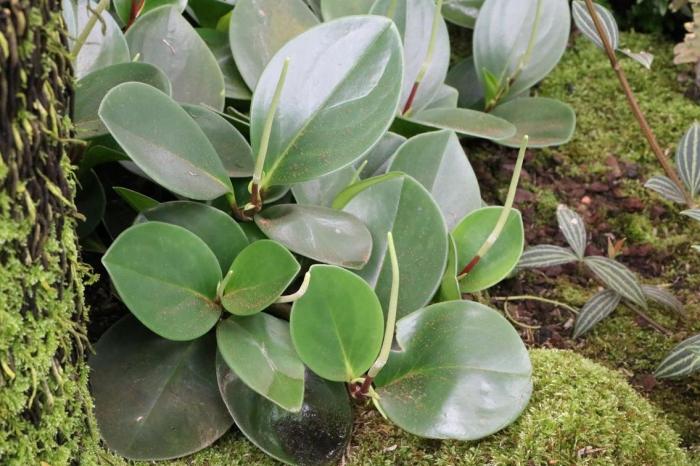Peperomia obtusifolia, commonly known as jade plant or pepper face, is a popular houseplant. Its thick, glossy leaves and compact growth make it a favorite among plant enthusiasts. Caring for this resilient plant is straightforward, making it an ideal choice for beginners. This article will explore how to care for your Peperomia obtusifolia to ensure it thrives in your home.
Understanding Peperomia Obtusifolia
Peperomia obtusifolia is a succulent species native to South America. It is known for its attractive, fleshy leaves that can vary in color from deep green to variegated shades. This plant grows to about 12 inches tall and can spread out about 18 inches wide.
Peperomia is not a true jade plant, despite the common name. However, its resemblance to jade plants and easy care make it an appealing option for many indoor gardeners.
Light Requirements
Light is a crucial factor in the care of Peperomia obtusifolia. This plant thrives in bright, indirect sunlight. Here are some tips for providing the right light conditions:
Indirect Sunlight: Place your Peperomia near a window that receives filtered light. Direct sunlight can scorch its leaves.
Low Light Tolerance: While it prefers bright light, Peperomia can adapt to low light conditions. However, growth may slow down, and the plant might become leggy.
Rotate the Plant: To ensure even growth, rotate your Peperomia every few weeks. This helps all sides receive equal light exposure.
Watering Your Peperomia
Watering is another essential aspect of Peperomia care. Overwatering can lead to root rot, while underwatering can cause the plant to wilt. Here’s how to find the right balance:
Check the Soil: Before watering, check the soil moisture. Insert your finger about an inch deep into the soil. If it feels dry, it’s time to water.
Water Thoroughly: When watering, ensure the water seeps through the drainage holes at the bottom of the pot. This ensures that the roots receive adequate moisture.
Frequency: Generally, you should water every 1 to 2 weeks. Adjust this frequency based on your home’s humidity and temperature.
Humidity and Temperature
Peperomia obtusifolia enjoys moderate humidity levels. Here are some tips to maintain the right environment:
Humidity Needs: Aim for humidity levels around 40% to 50%. If your home is very dry, consider using a humidifier or placing a tray of water near the plant.
Temperature Range: This plant prefers temperatures between 65°F and 80°F (18°C to 27°C). Avoid placing it near drafts, heaters, or air conditioning vents.
Soil and Potting
Choosing the right soil and potting conditions is vital for the health of your Peperomia obtusifolia. Here are some recommendations:
Well-Draining Soil: Use a potting mix designed for succulents or cacti. This type of soil drains quickly and prevents waterlogging.
Pot with Drainage: Ensure your pot has drainage holes to allow excess water to escape. This helps prevent root rot.
Repotting: Consider repotting your Peperomia every couple of years. This refreshes the soil and gives the plant more room to grow.
Fertilizing Peperomia Obtusifolia
Fertilizing your Peperomia is not mandatory but can promote healthy growth. Here’s how to fertilize effectively:
Type of Fertilizer: Use a balanced, water-soluble fertilizer diluted to half strength. Look for a fertilizer that is low in nitrogen.
Fertilizing Schedule: Fertilize during the growing season, typically spring and summer. Apply every 4 to 6 weeks for the best results.
Avoid Over-Fertilizing: Too much fertilizer can harm your plant. Always follow the instructions on the fertilizer package.
Pruning and Maintenance
Regular pruning helps maintain the shape and health of your Peperomia obtusifolia. Here are some maintenance tips:
Remove Dead Leaves: Regularly check for and remove any yellow or dead leaves. This keeps the plant looking tidy and healthy.
Shape the Plant: If your Peperomia becomes leggy, trim back the stems to encourage bushier growth. Cut just above a leaf node to promote new growth.
Cleaning Leaves: Dust can accumulate on the leaves, affecting photosynthesis. Gently wipe the leaves with a damp cloth to keep them clean.
Common Pests and Diseases
While Peperomia obtusifolia is relatively pest-resistant, it can still attract some common pests. Here are some issues to watch for:
Spider Mites: These tiny pests thrive in dry conditions. You may notice webbing on the leaves. Increase humidity and use insecticidal soap to treat infestations.
Mealybugs: These pests appear as white cottony masses on the plant. Remove them with a cotton swab dipped in alcohol.
Root Rot: Overwatering can lead to root rot, a serious issue. If you notice wilting or yellowing leaves, check the roots. Remove any rotten roots and repot in fresh soil.
Propagating Peperomia Obtusifolia
If you want to expand your collection, propagating Peperomia obtusifolia is easy. Here’s how to do it:
Leaf Cuttings: Take a healthy leaf and cut it from the stem. Allow the cut end to callous over for a day.
Place in Soil: Plant the calloused leaf in a small pot filled with well-draining soil. Water lightly.
Provide Light and Humidity: Place the pot in bright, indirect light. Keep the soil slightly moist but not soggy.
Wait for Roots: In a few weeks, you should see new growth, indicating that roots have formed.
See also: How To Care Variegated Jade: A Comprehensive Guide
Conclusion
Caring for Peperomia obtusifolia jade is a rewarding experience. With its attractive leaves and easy care, it’s perfect for both beginners and seasoned plant lovers. By providing the right light, watering, humidity, and soil conditions, you can ensure your Peperomia thrives.
Regular maintenance, including pruning and cleaning, will keep your plant healthy and looking its best. Keep an eye out for pests and diseases, and don’t hesitate to propagate your plant for even more greenery in your home.
With these tips in mind, your Peperomia obtusifolia jade will flourish, bringing beauty and life to your indoor space. Happy gardening!
Related topics:


